Improving breeder performance with trace minerals
![Improved performance and stronger egg shells are some of the traits enhanced by chelated trace minerals. [Photo: World Poultry]](https://www.poultryworld.net/app/uploads/2021/04/001_419_rb-image-2724060-848x565.jpeg)
Nutritionists have the responsibility to ensure the health and productivity of the flock in addition to the quality of the egg and resulting chick. Trace minerals such as zinc, copper and manganese are essential to ensure adequate performance of the animal, functioning both as enzyme cofactors and as constituents of metalloenzymes.
Genetic selection has dramatically increased the performance of broiler and layer breeders, which also increased the overall demand for supplemental nutrients in diets. It is trace minerals which are key to egg and progeny development.
Zinc in particular is a constituent or activator of hundreds of enzymes and is essential for many aspects of growth, including DNA synthesis. Zinc also has an integral role in the synthesis of two important functional proteins: collagen and keratin.
These proteins have a significant impact on embryonic and post-natal development. Collagen is the major structural protein of internal tissues, including cartilage and bone. Keratin is the structural protein of feathers, skin, beak and claws. Zinc also influences chick development because of its effect on appetite. A deficiency or excess of zinc is associated with anorexia.
Copper is essential for reproduction and embryonic development and plays an important role in the proper crosslinking of collagen and elastin. Manganese is also essential for growth and fertility. It is crucial for embryonic and post-natal bone development of the growing chick.
When considering eggshell formation and integrity, zinc, copper and manganese are all important components for a strong shell. A zinc deficiency can lead to reduced shell weight and strength, as it is involved in supplying carbonate ions during shell formation. As shell membrane fibres are distributed, a lack of copper can result in egg-shape deformation and abnormal mechanical properties. Additionally, manganese activates an enzyme involved in the creation of glycosaminoglycans, which are components of proteoglycans. The proteoglycans are present in the eggshell matrix and are involved in the control of its structure and texture.
Hatching rate and progeny quality
Zinc, copper and manganese play a role, either individually or in combination, in supporting growth, production and maintenance of the structural integrity of tissues. Therefore, supplementing hens with highly bioavailable chelated sources of trace minerals will support not only the quality of eggs from breeder hens, but also hatching rate and progeny quality.
Increased bioavailability of chelated trace minerals can translate into improved performance, tissue development and integrity; as seen with improved eggshell breaking strength, hatchability, embryo development and chick quality. Enhanced immune response to vaccination and growth performance reflected by improved growth and feed conversion can also result from increased trace mineral bioavailability.
The increased bioavailability is attributable to reduced antagonistic reactions with other dietary constituents in the gastrointestinal tract. Use of a chelated trace mineral source, such as a metal methionine hydroxy analogue chelate (MMHAC), allows nutritionists to reduce the trace mineral content of the feed, while still meeting the animal’s nutritional requirements and improving key production parameters.
Improved breeder longevity
Longevity accounts for the number of days of life of a breeder hen. It is the time period between the date of housing and death, or removal from the house. Optimal longevity includes low culling and mortality rates and consistent egg production throughout the entire lay cycle, as well as maintained production during the late lay period. In order to remain highly productive throughout the entire lay cycle, birds’ immune systems and tissue integrity must remain in peak condition. Healthy birds remain in production longer, and optimal nutrition is a pre-requisite for optimal breeder performance.
Research conducted with broiler breeders from 18 weeks to 59 weeks of age shows including MMHAC in the diet decreased mortality by 13.53%, compared to breeder hens fed inorganic trace minerals (ITM) (Figure 1). Most important to breeder longevity, trace minerals can have a direct impact through improved immune response. More specifically, most adequate immune systems are due to strong gut health and tissue integrity.
When fed MMHAC, data shows broiler breeders have an enhanced coccidiosis immune response after being challenged with all three Eimeria species on Day 24 (Figure 4). As a factor of tissue integrity and gut health, intestinal strength also provides a measure to ensure adequate supplementation of trace minerals is being provided. Trial results show birds supplemented with MMHAC have improved strength of the Jejunum portion of the gut (Figure 5).
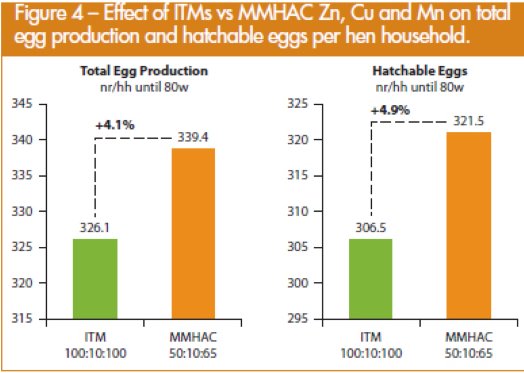
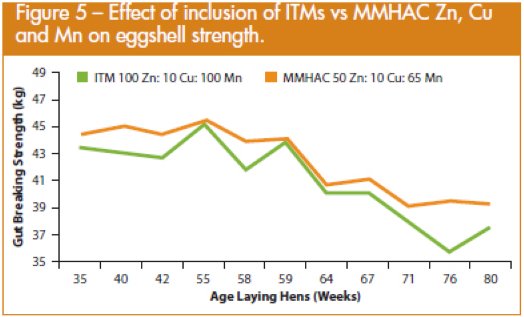
Given today’s intensive production system and consequential pressure for birds to continually meet performance parameters under various stressors, optimal trace mineral nutrition is more important than ever. In order for birds to maintain peak performance and produce the desired quality of eggs for longer periods of time, producers should look at all potential avenues to solve breeder longevity issues.
Utilising high-quality chelated trace minerals, such as MMHAC, increases flock longevity by supporting a strong immune system and tissue integrity, resulting in optimum production of quality eggs, with improved hatchability and chick quality. MMHAC provides a thorough trace mineral supplementation approach to address this prevalent industry pain.
Egg production, eggshell strength and hatchability
Research conducted with layer breeder producers in commercial conditions showed dramatic improvements in key production parameters for hens fed MMHAC. In one study, a 4.1% increase in total egg production per housed hen and a 4.9% increase in hatchable eggs per housed hen resulted with the inclusion of MMHAC in the diet rather than ITM sources of zinc, copper and manganese (Figure 1). Additionally, a consistent improvement in eggshell strength was seen in those layer breeder hens fed MMHAC over the 80-week period of the trial (Figure 2).
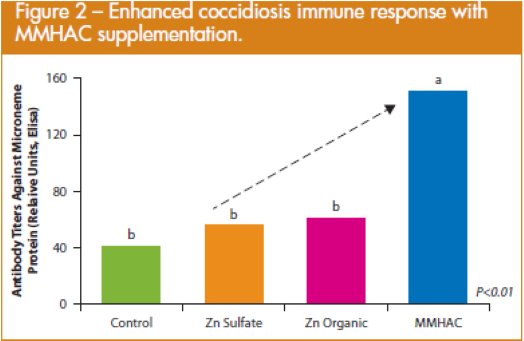
These results support replacing standard ITMs with MMHAC at lower supplementation levels to promote improved performance and stronger eggshells over the lay period, especially after 60 weeks of age when production begins to decrease. In a separate study, done with 15,200 heavy breeders, the inclusion of trace minerals as either MMHAC or a sulphate/oxide combination was compared. For birds fed MMHAC, the percentage of embryos alive at 18 days was improved and hatching rate increased by 2% at 36 weeks of age.
Embryo development
It’s important to realise that embryos develop outside the hen’s body. Therefore, mineral content in the egg yolk is crucial for optimum embryo development and progeny growth. In a research trial (Sun et al., 2012a), the inorganic source of zinc, copper and manganese was replaced with the corresponding MMHAC at a reduced level, and the mineral content of the egg yolks was measured (Figure 4).
This trial demonstrates commercial producers can improve embryo development by improving the trace mineral supply to the embryo, while reducing the diet’s overall mineral content. Given the physiological impact of trace minerals, this can favour the resulting chick’s immunity development and livability. This relationship can be further assessed by measuring the extent of bone mineralisation in the day-old chick.
Chick viability
To support improved progeny growth performance by including MMHAC in the diet, a trial was conducted to analyse the growth performance of 42-day-old chicks from hens fed different sources of trace minerals. Hatched healthy male chicks were randomly selected and fed a common commercial ration with inorganic mineral sources. Upon analysis, feeding MMHAC to broiler breeders increased the body weight, feed intake and feed conversion of progeny at 42 days of age (Table 2).
A major element in profitability of both layer and broiler breeder poultry operations is hen longevity. As birds are usually pushed to produce more eggs for extended periods of time, the additional stress can lead to decreased performance, and even increased mortality. In order to support optimal performance, nutritional factors should be considered to provide a stable basis from which birds can perform.
Reaching full potential
Trace minerals such as zinc, copper and manganese play an essential role in the maintenance of the health and productivity of the breeder bird. Supplementing breeder diets with MINTREX chelated trace minerals (MMHAC) maximises egg production and hatchability up to 80 weeks of age when compared to other organic and inorganic mineral sources.
Additionally, the inclusion of MINTREX in breeder diets supports increased mineral levels in the egg yolk, which then become available to the developing chick. As a result, the formation of key structural components, such as collagen and bone, is enhanced, as is the viability of the day-old chick. This additional nutritional support helps the chick to fully reach its genetic performance potential. The highly bioavailable forms of MINTREX achieve these effects at lower dietary concentrations than inorganic sources, thus reducing environmental impact and increasing profitability of breeder operations.
Author: Dr Ajay Bhoyar
Join 31,000+ subscribers
Subscribe to our newsletter to stay updated about all the need-to-know content in the poultry sector, three times a week. Beheer
Beheer
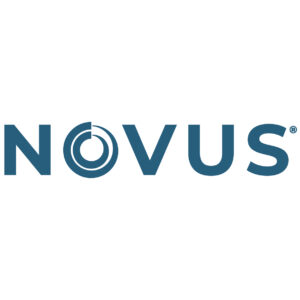



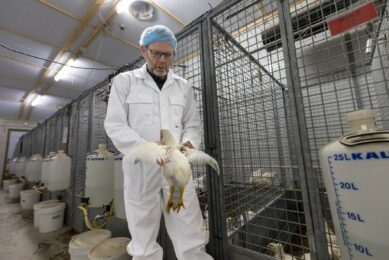



 WP Admin
WP Admin  Bewerk bericht
Bewerk bericht